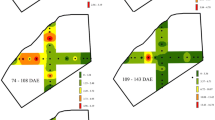Abstract
Spatial dispersion of the nymphs of the jassid, Amrasca biguttula biguttula (Ishida), and the adults of the whitefly, Bemisia tabaci Genn. on F414, a Gossypium hirsutum variety, was systematic in Ludhiana (Punjab). Both the jassid and the whitefly displayed no definite pattern along the height of the plant, though a maximum number of whiteflies were recorded at middle canopy (21–40 cm from bottom). Sample sizes of 10–15 plants, selected in a statistically linear fashion represented populations of jassid nymphs and adult whitefly on all four varieties. Sampling jassid nymphs by visual counting and whitefly by split-cage were the most suitable sampling methods for local cotton growers among the various methods compared.
Résumé
La distribution spatiale des nymphes jassids Amrasca biguttula biguttula (Ishida) et le whitefly adult Bemisia tabaci, Genn.) sur la variété F414, a hirsutum était uniforme a Ludhiana (Punjab). Le jaseis aussi bien que le whitefly ne manifestaient anoun échantillon le long de la hauteur de la plantes bien que. Un maximum nombre de whiteflies ont été remarques au dalis central (21–40 cm du bas). Des échantillons de 10–15 plantes, sélectionnés d’une façon liveaive, représentaient statistiquement des populations des nymphes jassids et whitefly adult surtoutes les quatre variétés. Le chantionnage des nymphes jassids en les comptant visuellement et des whiteflies par “split-cage” était le plus convenable pour les cultivateur du coton a Ludhiana parmi les méthodes comparées.
Similar content being viewed by others
References
Afzal M. and Ghani M. A. (1953) Cotton jassid in the Punjab. Sei. Monogr. Pakistan Ass. Advance. Sei. No. 2.
Allen J. D. G. and Gokhale D. V. (1972) Sequential sampling plans for the boolworm, Heliothis zea. Environ. Ent. 7, 771–780.
Arbous A. G. and Kerrich J. E. (1951) Accident statistics and concept of accident proneness. Biometrics 7, 340–432.
Byerly K. F., Gutierrez A. P., Jones R. E. and Luck R. F. (1978) A comparison of sampling methods for some arthropod populations in cotton. Hilgardia 46, 257–282.
Dyck V. A. (1980) Sampling techniques for important rice pests. Paper presented at workshop on Integrated Pest Control in Rice, September 22–27, Yogyakarta, Indonesia.
Ingram W. R. and Green S. M. (1972) Sequential sampling for bollworms on rain grown cotton in Botswana. Cotton Grow. Rev. 49, 265–275.
Kuehl R. O. and Fye R. E. (1972) An analysis of the sampling distributions of cotton insects in Arizona. J. econ. Ent. 65, 855–860.
Lincoln C. (1978) Procedures for scouting and monitoring for cotton insects. Arkans. Agric. exp. Stn Bull. Vol. 829.
Lowe J. A. (1970) Rice Survey of 1970. The Ford Foundation, New Delhi.
Madjar V. M., Cohen S., Chen M., Tarn S. and Rasilio D. (1982) A method for monitoring Bemisia tabaci and timing spray applications against the pest in cotton fields in Israel. Phytoparasitica 10, 85–91.
Mahal M. S. and Singh B. (1979) Population build-up of cotton jassid and index of its injury as a measure of resistance in Okra. Indian J. Ecol. 6, 74–81.
Morrisita M. (1962) IS-index, a measure of dispersion of individuals. Res. Popul. Ecol. 4, 1–7.
Panse V. G. and Sukhatme P. V. (1967) Statistical Methods for Agricultural Workers. Indian Council for Agricultural Research, New Delhi.
Pieters E. P. (1978a) Comparison of sample-units sizes for D-vac sampling of cotton Arthropods in Mississippi. J. econ. Ent. 71, 107–108.
Pieters E. P. (1978b) Bibliography of sequential sampling plans for insects. Bull. ent. Soc. Am. 24, 372–374.
Regniere J. and Saunders C. J. (1983) Optimal sample size for the estimation of spruce budworm (Lepidoptera: Tortricidae) populations on balsam Fir and White spruce. Can. Ent. 115, 1621–1626.
Singh H. (1978) Studies on the insect pest infestation in relation to phenology of arboreum cotton. M.Sc. thesis (unpublished) Punjab Agricultural University, Ludhiana.
Southwood T. R. E. (1978) Ecological Methods with Particular Reference to the Study of Insect Populations. Champman & Hall, London.
Suri S. M. (1971) Evolving spray schedule for the control of insect infesting desi cotton in the Punjab. M.Sc. (Argi) thesis. Punjab Agricultural University, Ludhiana. Unpublished.
Wolfenbarger D. A. (1977) Boll weevil, bollworm and tobacco budworm and fruiting structures of the cotton plant: number of plants that must be sampled at different square populations and percentage damaged. J. econ. Eni. 70, 791–793.
Yuen-Shaung N. G., Trout J. R. and Ahmad S. (1983) Sequential sampling plans for larval populations of the Japanese Beetle (Coleoptera: Scarabaeidae) in Turfgrass. J. econ. Ent. 76, 251–253.
Author information
Authors and Affiliations
Additional information
Part of a Ph.D. thesis submitted to Department of Entomology, Punjab Agricultural University, Ludhiana, India.
Rights and permissions
About this article
Cite this article
Chakravarthy, A.K., Ananda Rao, P.K. Dispersion Patterns, Sample Unit-Sizes and Techniques for Sampling Cotton Jassid [Amrasca biguttula biguttula (Ishida)] and Whitefly (Bemisia tabaci, Genn.). Int J Trop Insect Sci 6, 661–665 (1985). https://doi.org/10.1017/S1742758400002861
Received:
Revised:
Published:
Issue Date:
DOI: https://doi.org/10.1017/S1742758400002861



